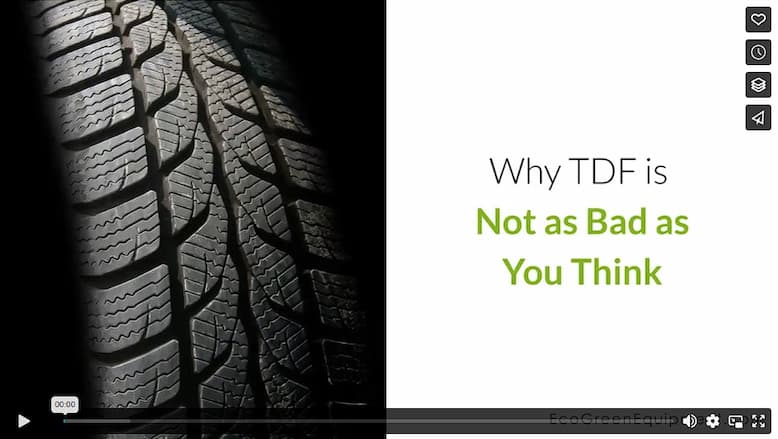Around 1979, tire-derived fuel (TDF) emerged as the first market for recycled tires. The fuel source consisting of whole tires or tire shreds mixed with traditional fossil fuel sources proved helpful in cleaning up tire stockpiles and providing an energy alternative. To this point, the high energy needs of utility boilers, pulp and paper mills, and cement kilns could only be met by burning large amounts of coal or other non-renewable fuel sources.
Over the next decade, TDF remained the best and most effective use of old tires. 98% of the waste tires produced in 1990 burned as TDF. Although the number of tires used in TDF has continued to rise, advances in tire recycling have introduced several new recycled rubber products that now makeup over 50% of the tire recycling market.
Is TDF safe to burn?
With all the dangers associated with tire fires, it seems counterintuitive to use them as a fuel source and voluntarily expose ourselves and our planet to the toxic chemicals produced. However, burning tires in a controlled system at cement factories or paper plants has been the subject of multiple studies. A research paper published by the Environmental Protection Agency in 1997 concluded that burning 10-20% TDF as a supplementary fuel source did not make a significant change to emissions provided the plant met certain criteria, including:
- Burning TDF in proper applications
- Facilities comply with state and federal regulations
- TDF is burned at high temperatures to achieve complete combustion
- Particulate controls such as fabric filters and electrostatic precipitators are in place
Further studies are underway at local and national levels on stack emissions at plants that burn TDF. However, early evidence from the data collected indicates a decreased carcinogenic risk from plants that incorporate TDF rather than relying wholly on fossil fuels.
What are the benefits of burning TDF?
1. Decreases Dependence on Fossil Fuels
As our hunger for energy grows worldwide, our draw on non-renewable energy sources is growing as well. Incorporating alternative fuels helps decreases our need to tap into these energy reserves.
2. Reduces Waste
With the United States producing hundreds of millions of scrap tires each year, we need ways to dispose of them or recycle them into useful products. Otherwise, they end up in landfills or stockpiles where they are an environmental hazard. We turn hundreds of millions of tires each year into energy used to produce cement, paper, and electricity using TDF. TDF and coal burned in a cement kiln produce ash that can be incorporated into the end product, resulting in zero waste. It contributes nothing to our landfills.
3. Inexpensive
In the United States, we do not produce enough fossil fuels to meet our own needs. Instead, we rely on imports from foreign countries. The price tag attached is often higher than we want and can fluctuate wildly with changes in foreign policy or current events. The cost is further elevated by the need to ship the fuel from its source to the user.
Waste tires are everywhere, in every state and every country. They do not need to be shipped long distances, and the cost to acquire the tires is low. Because of the degradation they undergo, stockpiled tires are no longer suitable for some recycling products. These tires may be burned as TDF or used in civil engineering projects on a limited basis. They are a solid waste product that we can use instead of traditional fuel sources—saving time and preserving natural resources.
4. Reduces Emissions
Burning coal and wood produce other harmful emissions in addition to carbon dioxide. Oxides of nitrogen and sulfur can be detrimental to the lungs if inhaled. Adding TDF to fossil fuel burning plants can help reduce the production of these damaging chemicals. In some states, the practice is recommended as a safety measure. In plants designed to burn TDF to produce energy, the emissions can be much lower burning TDF instead of solid fuel.
5. Consistent High BTUs
The heat produced by burning fossil fuel may wax and wane as the fire burns. TDF generates a steady burn that produces consistent heat, maintaining the high temperatures required in cement kilns.
On average, coal and wood can produce 12,000 and 5,000 BTUs per pound, respectively. TDF, however, can provide between 12,000 and 16,000 BTUs per pound, making TDF a better choice for energy production.
TDF has been in use as an alternative fuel source in the United States for over 40 years. The research done on its safety both to the environment and the people living there has shown that it can be a good, clean energy source. It is also an environmentally-friendly solution to our growing tire problem.
Video





